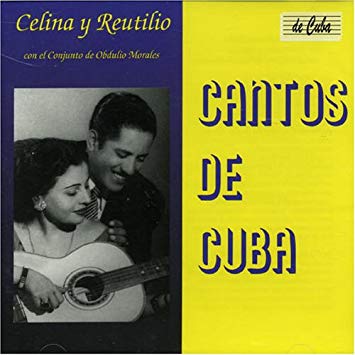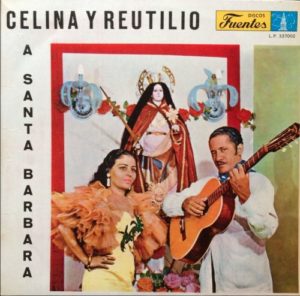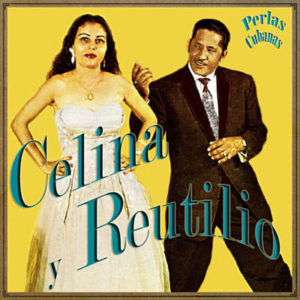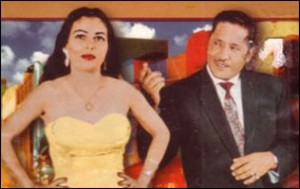 CELINA Y REUTILIO, THE CUBAN DUO THAT LINKED GUAJIRA AND AFRO MUSIC. VIDEOS.
CELINA Y REUTILIO, THE CUBAN DUO THAT LINKED GUAJIRA AND AFRO MUSIC. VIDEOS.
Celina González Zamora was born in Jovellanos, March 16, 1928, in the town of Nueva Luisa, in the province of Matanzas. Of peasant parents, when Celina was a child, her parents and siblings sang in the weekend family parties. Angela, playing the three and singing and Jesus, the lute. Celina thus learns the melodic and rhythmic basis of cajun guajiro, and of her mother’s devotion, by the creole religions of Cuba, and of the orishas: Ochún, Babalú Ayé, Changó and Yemayá.
During his childhood, his family moved to Santiago de Cuba. Thanks to the radio and his predilection for the Cuban point sound he began to improvise some tenths and quartets, around 1943 he meets the one who will be the love of his life, Reutilio.
Reutilio Domínguez Terrero was born in Guantánamo, Oriente on April 2, 1921 and died in 1971; Guitarist, composer and singer. Reutilio highlighted singing on a radio station in Guantánamo.
https://youtu.be/TZoJ5wHW-Ow
The duo becomes known in Santiago de Cuba. Finally, in 1947 they make their debut on a radio station, the CMKR.
Another popular musician from Santiago, already established in the national environment, Antonio Fernández, better known as Ñico Saquito; author of songs like “María Cristina”, “Adiós Compay Gato”, “Jaleo”, “Do not leave the path by path” and the prototype of the protest song “Al vaivén de mi Carreta”, takes them to Havana in 1948 to that appear in a regional station, Radio Cadena Suaritos. This radio station had made fashionable the most purely African music of the country, presenting on the weekends touches and songs of the santera religion with vocalists like Celia Cruz, Mercedes Valdés and Gina Martín.
For her Havana debut, Celina and Reutilio compose a number that becomes the duo’s signature: “A Santa Bárbara”, also known as “Que viva Changó”. The success of this guaracha was immediate and resounding.
With this composition Celina and Reutilio break with an old separation that existed between the Guajira music and the Afro music, they establish a new fusion where the metric, that is, the Hispanic tenth and the style of the guajiro point, remain, but the lyrics are refers to issues of the cultural heritage of the black continent.
In the traditional duos and trios of Cuban point and montuno are generally used two guitars, or a guitar and another string instrument. A musician played the so-called “prima guitar”, that is, the high pitched tunes, as is the case of Miguel Matamoros in his trio, while a second guitarist ‘bordoneaba’, that is, he marked the bass tones, as Rafael Cueto did with his famous ‘tumbaos’ in the Matamoros Trio. Reutilio Dominguez met a developed technique, as well as fingers, wrist and forearm supremely flexible that allowed him to play the cousin and bordonear at the same time, so that the duo of Celina and Reutilio sounded like a trio.
In a short time Celina and Reutilio became national favorites. The formula of combining the tenths and quartets typical of Guajiro singing with themes of the deities of the Yoruba and Congos pantheons of the African past had great response from the public, and the duo began to produce a whole series of similar numbers such as “A la reina del mar “,” El hijo de Elegua “,” A la charidad del Cobre “and others. They also recorded a quantity of Guajira music and are montuno of other authors, such as “Lágrimas negras”, “They had me tied with P” -composed by Ñico Saquito-, “El cuarto de Tula” and many more.
The tunes of Celina and Reutilio begin to circulate in countries of the Caribbean basin; in particular, Colombia, Venezuela and the Dominican Republic. One of his numbers, recorded at a time when Guajira music showed signs of weakness in its popularity, I am the Cuban point, becomes along with, A Santa Bárbara in another legendary success of Celina and Reutilio, which runs through several countries of Latin America.
The collaboration of Celina and Reutilio lasted until their separation in 1964. Reutilio died in 1971. Between 1964 and 1980 Celina González continued her solo career. From 1980 a new stage in the career of Celina begins. His son Lázaro Reutilio finished his formal music classes and mother and son decided to release a new version of Celina and Reutilio. Relying on the musical cast of the peasant music program “Palmas y Cañas”, the new Celina and Reutilio is no longer a duo but a modern set of guajira music and montuno, with Celina and her son Reutilio as the star voices.
Celina and Reutilio also triumph in Europe, where they have achieved success in the United Kingdom, where it is known as “Queen of Cuban Country Music” in Sweden, France and Greece. Celina has dabbled in the Nueva Trova songs, particularly in the work of Silvio Rodríguez, Girón; In addition, he has worked with the groups Manguaré and Adalberto Álvarez and his son, with whom he recorded two long-playing records “.
Celina has influenced an increasing number of peasant singers inside and outside of Cuba. Its impact on Cuban music is widely recognized. As Alejandro Ulloa has written, Celina is a guajira music, what Celia Cruz has been for the guaracha and son.
 CELINA Y REUTILIO, EL DÚO QUE UNIÓ LA MÚSICA GUAJIRA Y LA MÚSICA AFRO. VIDEOS.
CELINA Y REUTILIO, EL DÚO QUE UNIÓ LA MÚSICA GUAJIRA Y LA MÚSICA AFRO. VIDEOS.
Celina González Zamora nació en Jovellanos, 16 de marzo de 1928, en la localidad de Nueva Luisa, en la provincia de Matanzas. De padres campesinos, cuando Celina era niña, sus padres y hermanos cantaban en los saraos familiares de fin de semana. Ángela, tocando el tres y cantando y Jesús, el laúd. Celina aprende así la base melódica y rítmica del cante guajiro, y de su madre la devoción, por las religiones criollas de Cuba, y de los orishas: Ochún, Babalú Ayé, Changó y Yemayá.
Durante su infancia, su familia mudó a Santiago de Cuba. Gracias a la radio y a su predilección por el sonido punto cubano comenzó a improvisar alguna que otra décima y cuarteta, hacia 1943 conoce al que va a ser el amor de su vida, Reutilio.
Reutilio Domínguez Terrero nació en Guantánamo, Oriente en Abril 2, 1921 y muere en 1971; Guitarrista, compositor y cantante. Reutilio destacó cantando en una emisora de radio en Guantánamo.
https://youtu.be/K0_0frqtOok
El dúo se hace conocido en Santiago de Cuba. Finalmente, en 1947 hacen su debut en una emisora de radio, la CMKR.
Otro popular músico santiaguero, ya establecido en el ambiente nacional, Antonio Fernández, más conocido como Ñico Saquito; autor de sones como “María Cristina”, “Adiós Compay Gato”, “Jaleo”, “No dejes el camino por vereda” y del prototipo de la canción protesta “Al vaivén de mi Carreta”, los lleva a La Habana en 1948 para que aparezcan en una estación regional, Radio Cadena Suaritos. Esta radioemisora había puesto de moda la música más puramente africana del país, presentando los fines de semana toques y cantos de la religión santera con vocalistas como Celia Cruz, Mercedes Valdés y Gina Martín.
Para su debut habanero, Celina y Reutilio componen un número que se convierte en insignia del dúo: “A Santa Bárbara”, conocido también como “Que viva Changó”. El éxito de ésta guaracha fue inmediata y rotunda.
Con esta composición Celina y Reutilio rompen con una vieja separación que existía entre la música guajira y la música afro, establecen una nueva fusión donde la métrica, o sea, la décima hispánica y el estilo del punto guajiro, se mantienen, pero la letra se refiere a temas del patrimonio cultural del continente negro.
En los tradicionales dúos y tríos de punto cubano y son montuno generalmente se utilizaban dos guitarras, o una guitarra y otro instrumento de cuerdas. Un músico tocaba la llamada “guitarra prima”, o sea, los tonos agudos, como es el caso de Miguel Matamoros en su trío, mientras que un segundo guitarrista ‘bordoneaba’, es decir, marcaba los tonos bajos, como hacía Rafael Cueto con sus famosos ‘tumbaos’ en el Trío Matamoros. Reutilio Domínguez reunía una desarrollada técnica, así como dedos, muñeca y antebrazo supremamente flexibles que le permitían tocar la prima y bordonear al mismo tiempo, de manera que el dúo de Celina y Reutilio sonaba como un trío.
http://youtu.be/HlMsZ8mTGHs
En poco tiempo Celina y Reutilio se convirtieron en favoritos nacionales. La fórmula de combinar las décimas y cuartetas típicas del cantar guajiro con temas de las deidades de los panteones yorubas y congos del pasado africano tuvo gran respuesta del público, y el dúo comenzó a producir toda una serie de números similares como “A la reina del mar”, “El hijo de Elegua”, “A la caridad del Cobre” y otros. Además grabaron una cantidad de música guajira y son montuno de otros autores, como “Lágrimas negras”, “Me tenían amarrao con P” –compuesto por Ñico Saquito–, “El cuarto de Tula” y muchos más.
Las tonadas de Celina y Reutilio comienzan a circular por países de la cuenca del Caribe; en particular, Colombia, Venezuela y República Dominicana. Uno de sus números, grabado en una época en que la música guajira daba señas de flaqueza en su popularidad, Yo soy el punto cubano, se convierte junto con, A Santa Bárbara en otro legendario éxito de Celina y Reutilio, que recorre varios países de América Latina.
La colaboración de Celina y Reutilio duró hasta su separación en 1964. Reutilio falleció en 1971. Entre 1964 y 1980 Celina González prosiguió su carrera como solista. A partir de 1980 comienza una nueva etapa en la carrera de Celina. Su hijo Lázaro Reutilio terminaba sus clases formales de música y madre e hijo deciden lanzar una nueva versión de Celina y Reutilio. Apoyándose en el elenco musical del programa de música campesina “Palmas y Cañas”, el nuevo Celina y Reutilio ya no es un dúo sino un conjunto moderno de música guajira y son montuno, con Celina y su hijo Reutilio como las voces estelares.
Celina y Reutilio triunfan también en Europa, donde han cosechado éxitos en el Reino unido, donde es conocida como, “Queen of Cuban Country Music”, en Suecia, Francia y Grecia. Celina ha incursionado en las canciones de la Nueva Trova, particularmente en la obra de Silvio Rodríguez, Girón; además, ha trabajado con los grupos Manguaré y Adalberto Álvarez y su son, con quienes grabó dos discos de larga duración”.
Celina ha influido sobre un número creciente de cantoras campesinas dentro y fuera de Cuba. Su impacto en la música cubana es ampliamente reconocido. Como ha escrito Alejandro Ulloa, Celina es a la música guajira, lo que Celia Cruz ha sido para la guaracha y el son.
Agencies/Wiki/ Celina y Reutilio/ Internet Photos/ YouTube/ Arnoldo Varona/ TheCubanHistory.com
THE CUBAN HISTORY, HOLLYWOOD.







